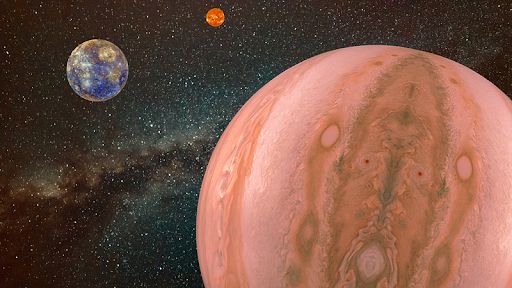In the Pursuit of Extraterrestrial Life, Scientists Explore Extrasolar Earth-Jupiter Pairs
Among the various small planets similar to Earth in existence, which ones possess counterparts resembling Jupiter? Identifying such planets could prove crucial in our quest to locate habitable environments.
The compilation of the Kepler Giant Planet Search catalog marks a significant achievement in the field of astronomy. Over the course of ten years, scientists have meticulously documented a collection of exoplanets that share similarities in size with Earth and are accompanied by a Jupiter-like celestial body. This groundbreaking catalog holds immense potential in our quest to uncover extraterrestrial life within the vast expanse of the Milky Way.

The team emphasizes the importance of identifying exoplanets that exist in such configurations, orbiting their respective stars. They believe that this discovery could play a pivotal role in our ongoing exploration for life beyond our own planet. Jupiter, in particular, has been recognized as a crucial factor in the development of life on Earth.
Scientists posit that the gas giant’s gravitational influence during the early stages of our solar system propelled rocky and icy debris towards the young sun. These fragments acted as the building blocks for the formation of our primordial Earth. Furthermore, it is speculated that some of this debris may have carried essential components for life as we know it, including water and foundational elements of complex molecules.
Lauren Weiss, the team leader and an assistant professor at The University of Notre Dame, expresses her excitement about this unprecedented catalog. She describes it as an unparalleled opportunity to explore the diversity of planetary systems that exist beyond our solar system. This compilation not only provides insights into systems resembling our own, but it also offers a chance to redefine our understanding of planetary formation.
Weiss’s research focus over the past decade has revolved around a fundamental question: among the other Earth-like planets in existence, which ones possess Jupiter-like siblings? This characteristic holds significant importance in our pursuit of locating potential habitats for life. By unraveling this mystery, we may gain valuable knowledge about the whereabouts of life in the cosmos.
Watching ‘wobbly stars’ to spot far-out planets
Weiss and his team constructed the catalog by utilizing data gathered from the W. M. Keck Observatory situated on Mauna Kea, Hawaii. This data allowed them to record the radial velocities, which refers to the speed at which an object moves away from Earth, of 63 sun-like stars that collectively host 157 small planets.
These planets vary in size, ranging from being slightly smaller than Earth (around the width of Mars) to being four times the size of our planet (approximately the diameter of Neptune). Some of these planets are believed to possess solid rocky surfaces that could potentially sustain life as we know it. During their analysis, the researchers also identified 13 Jupiter-like planets, eight planets similar in size to Neptune, and three companion stars orbiting the main target stars.
Despite their significant sizes, Jupiter-like planets can be challenging to detect when they are located far away from their stars or do not regularly transit across the face of their parent stars from our perspective on Earth. Moreover, if these planets are tilted, the resulting dimming of starlight during their transits is minimal and easily overlooked.
The team employed the radial velocity technique, which measures the change in a star’s light caused by the gravitational pull of a planet. This gravitational interaction causes the star to subtly “wobble” and move back and forth in relation to Earth.
“Jupiters are massive, and they exert a considerable gravitational force on the stars we can observe. We can detect them by conducting numerous measurements over an extended period, which is precisely what we had to do,” explained Weiss.
For each star included in the study, Weiss and his colleagues had to measure the light shift for a minimum of 10 nights, and sometimes even for several hundred nights, while remotely operating the Keck telescope from observation stations. The duration of observation varied depending on the specific star being studied, as determined by Weiss and his team.
In addition to the discovery of Jupiter-like planets and the provision of a catalog of Earth-like worlds accompanied by larger sibling planets, the research conducted by this team serves as the primary paper in the Kepler Giant Planet Search. Consequently, it will serve as the cornerstone for future investigations. Subsequent studies will delve into the orbital structure of distant planetary systems, while others will contribute to the refinement of planetary detection techniques. Furthermore, certain studies will compile data on partnerships between giant and small planets.
Weiss, in conclusion, expressed his utmost enthusiasm for revisiting the narrative of Earth’s formation. With the wealth of information now available regarding various planetary systems, the team is actively searching for patterns and making new discoveries. These possibilities truly ignite his excitement.
The team’s research is set to be published in the Astrophysical Journal.
This article is republished from SpaceCom under a Creative Commons license. Read the original article.
Do not forget to share your opinion with us to provide you with the best posts !



0 Comments